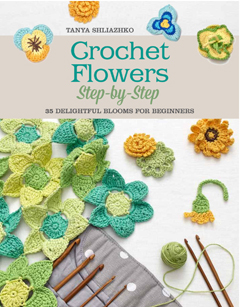Would you be interested in finding patterns, instructions and ideas for making a spectacular variety of flowers using a single flower loom or a flower loom kit? And would you also be interested in learning how to use crochet to transform the flowers into motifs such as squares, circles and hexagons — and then learning how to make your motifs into finished projects such as blankets, potholders, a tote bag and a scarf?
Perhaps you’ve inherited or purchased a vintage flower loom such as a Daisy loom that didn’t come with its original instructions — and so you have no idea how to use your loom to actually make flowers. Or perhaps you bought a newer flower loom, and you’re bored with the small number of patterns that came with your loom (or maybe yours didn’t come with any patterns). Maybe you don’t even have a flower loom yet, but you’re thinking you might like to get one and give this technique a try.
Whatever your current experience level with flower looming is, Crochet Loom Blooms: 30 Fabulous Crochet Flowers & Projects is a book you need to know about. If the topic of flower loom crafts is of interest to you, and you want to learn more about it, you’ll want to consider adding this outstanding book to your library.
I’ve owned several other books on the topic of flower looming in addition to this one. There aren’t all that many books on the topic of flower looming to start with; so at this time, you don’t have huge numbers of choices for instruction books if you want to learn this technique. Out of all the flower looming books I’m aware of, Crochet Loom Blooms is the most comprehensive. It includes instructions for 30 different loomed flowers and 5 finished projects. These designs almost all incorporate both loomed flowers and crochet stitches (although 5 of the designs included in the book don’t require any crochet).
Crochet Loom Blooms is a beautiful and appealing book; the projects included are all well worth making. Even if it weren’t one of the only available texts on the topic of flower looming, my opinion is that it would stand on its own merit as being well worth buying.
Book Details:
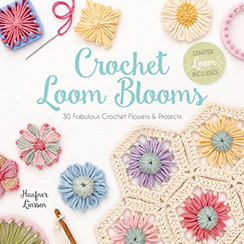
Author: Haafner Linssen
Publisher: Interweave
Copyright Date: 2018
ISBN 13: 978-1-63250-619-1
ISBN 10: 1-63250-619-X
Book Formats:
This book is available as a softcover book with perfect binding. This edition comes with a small starter loom made of a heavy cardstock paper material that works astonishingly well considering what it’s made of. This is the format of the book I have in hand for review, and I found it wonderful to work with. This is a first class publication, with high-quality paper that shows off the color photographs well, plus a sturdy binding. The book has a substantial but not overly hefty feel to it. The softcover edition of the book is available From Amazon and numerous other retailers.
Number of Pages: 128
Skill Level: This book is suitable for crafters of all skill levels, including total beginners. The book includes illustrated tutorials for basic crochet techniques in addition to all the flower loom patterns, instructions and ideas.
Finished Craft Projects Included in This Book:
“Vintage Potholder”
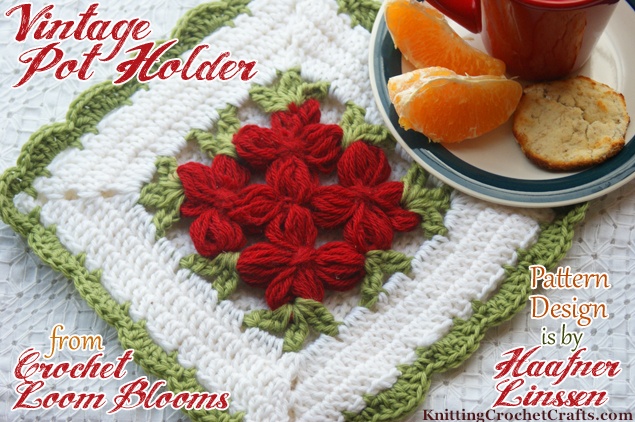
If you’re new to either flower looming or crochet (or both), this is a fantastic starter project for getting acquainted with the process of using these two craft techniques together. Both the crochet work and the flower loom work needed for this project are really easy — but the results are super satisfying when you’re finished.
If you’re new to yarn crafting, and you make some mistakes when you make your potholder(s), you’ll find this medium to be quite forgiving.
It’s a good idea to choose a non-wearable project like this one as your first, because your potholder will still protect your hands from burns even if you accidentally add a few extra stitches or do something a little weird as you crochet — and no one is likely to notice or care.
This was the project I started on immediately as soon as I received my copy of this book. I LOVE how my potholder turned out! It’s simply gorgeous!
I also found it to be a fun and interesting project to work on. When it comes to making pairs of items, I sometimes avoid it — because there are times when I have a hard time motivating to make a second item to complete the pair. I don’t see that being a problem with this particular project. I’m looking forward to making a second one of these.
If you spend any time at all cooking in your kitchen, I’m betting you’d love to have a pair of these beautiful, double-thick potholders available for preventing burned fingers. They’re so pretty that you probably won’t want to hide them in a linen drawer; I’m positive you’ll want to display them proudly.
Because I recently moved and wasn’t able to bring any of my hot pads, trivets or potholders with me, and because we do a lot of cooking from scratch using gigantic pots and pans, I decided to supersize my project to make it more of a dual purpose hot pad / potholder. By most peoples’ standards, my finished potholder is gigantic, measuring about 10 inches– but it’s perfect for what I need it to do. I achieved this large size by using Cascade 220 worsted weight yarn and a size H /5.0 mm crochet hook. If you don’t need a massive potholder / hot pad, it’s better to stick with Haafner’s suggested yarn weight, which results in a potholder measuring 5 1/2 inches.
If you buy a softcover copy of the book, you’ll most likely be able to make this potholder even if you don’t have a flower loom yet. I made my potholder using the starter loom that comes with the book, and it worked well for this project. I was surprised at how easy it was to use.
There are templates for making your own starter looms included in the softcover edition of the book.
Floating Flowers Scarf
This is another super easy, beginner-friendly project that would be a good one to start with if you are new to either the flower looming technique or to crochet itself. This is about the simplest possible example I can imagine of a flower loomed project, and the crochet work is also exceptionally easy.
Haafner Linssen, the author of this book, is gifted with a special kind of genius for taking ultra-simple stitches and putting them together into projects that look totally sophisticated. This scarf is one example of that. It’s a versatile design that you’ll more than likely want to add to your wardrobe; you’ll be able to use it to dress up simple outfits like jeans and a sweater, and it also goes well with everything from khakis to dresses to business attire.
Tote Bag
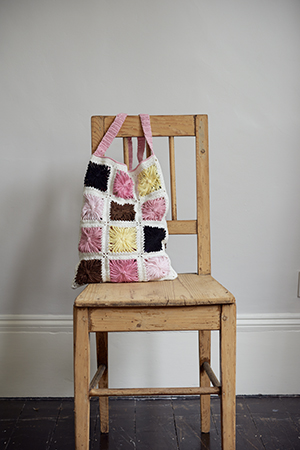
This pretty tote bag pattern includes instructions for crocheting a strap, so you won’t have to buy separate purse handles to complete the project. It also includes instructions for sewing an optional lining — so you can carry small items in it if you decide you want to add that option to your bag. The bag is a unique and unusual design based on square flower motifs. It’s easy to change the bag’s dimensions to customize it for whatever you need to carry; you can decide if you want it to be a market bag, purse, beach bag, book bag or other sort of bag.
Vinni’s Blanket — Would Make a Lovely Baby Blanket
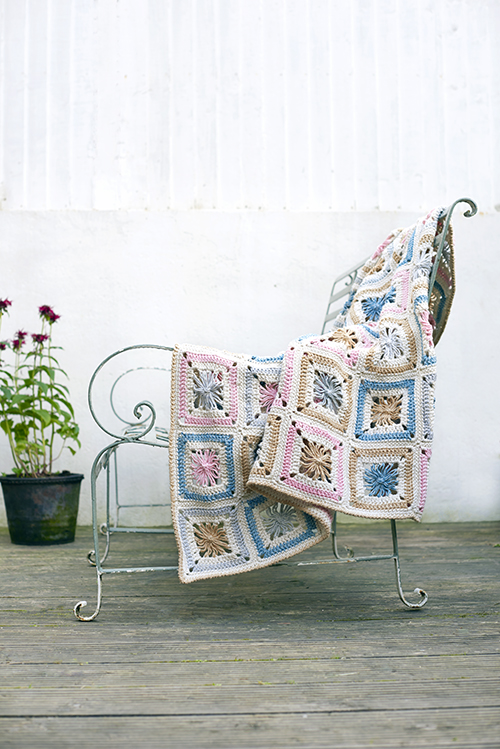
This lovely design offers you a unique twist on the traditional crochet granny square blanket. You start each square off with a square loom-made flower motif and then build additional crocheted rounds out from the flower centers. Then you join the squares together as usual and add an edging to complete your blanket. This looks like a fun, interesting and useful project.
The original colorway included in the book is just right if you want to make a baby blanket that could work for either baby boys or baby girls — and it would also be an adorable addition to a teen or ‘tween girl’s room. The blanket colorway is pastel pink and blue paired with neutral beige, gray and off-white. (If you know for sure a new baby boy is on the way, or you want to make this blanket for an older boy, you could change out the pink for another color that’s more masculine — perhaps orange, red or green).
The finished blanket size is 40″ x 46″, which is a bit bigger than all the other baby afghans I’ve ever crocheted; but I think it’s a nice size if you want to make a blanket that would be likely to accompany the baby into childhood instead of being quickly outgrown.
Chunky Throw
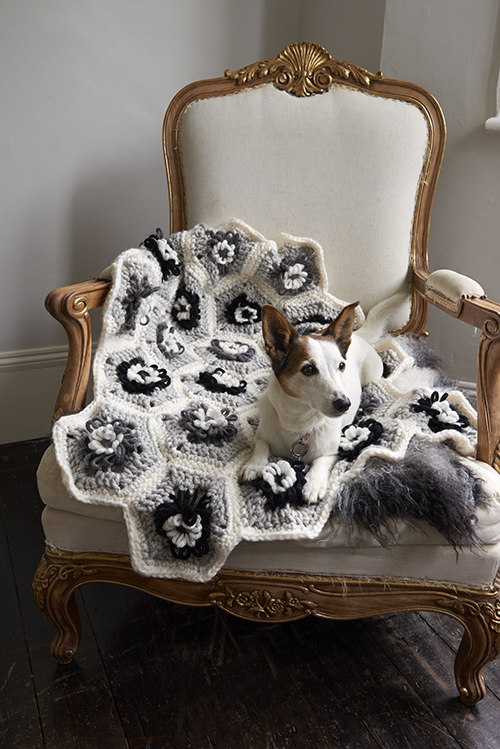
This cute throw is based on a hexagon motif pattern made with 2 different loom sizes. It looks like a warm, cozy and practical blanket, perfect for snuggling under when it’s chilly.
30 Flower Motifs
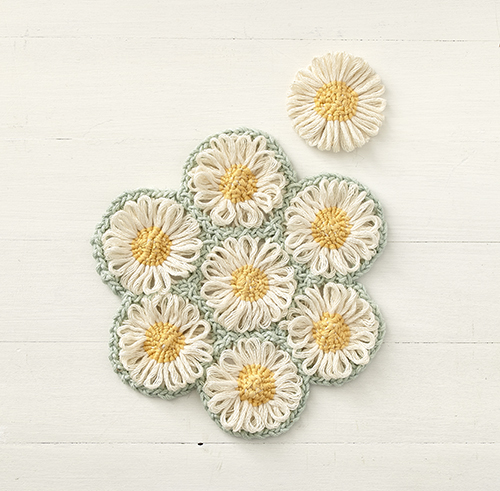
Most of the flower motifs in this book are abstract designs that are instantly recognizable as flowers; a few are representational of actual flowers like daisies and cherry blossoms. The project samples in the book have been worked in a wide range of colors — some of which are bright and cheerful, some of which are pretty pastels and some of which are more subdued and masculine.
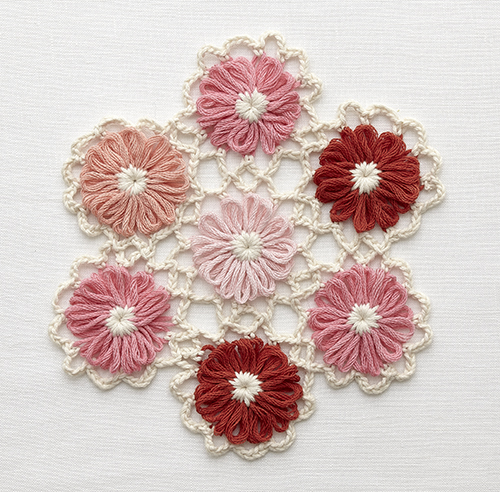
While most of the designs in this book are girly and feminine, surprisingly, there are a few designs in this book that could possibly work for decorating a bachelor pad (of course, that depends on the tastes of the bachelor in question…).
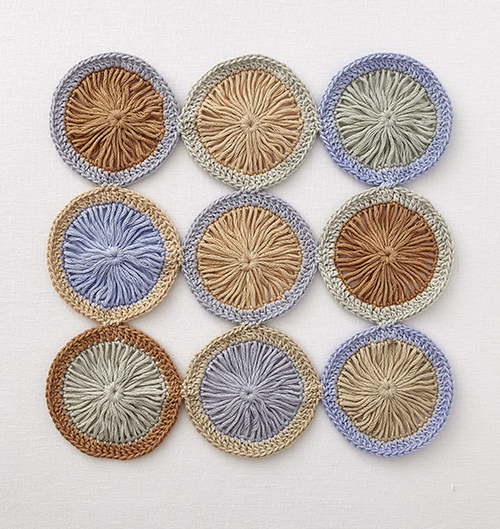
There’s a design called “Formal Flower Bed” that I think could work well with Craftsman style design and would pair well with Gustav Stickley’s furniture or other mission style furnishings. The Formal Flower Bed design could work well for making the table runner or other linens in a guy-friendly abode, not to mention decorative pillows to adorn the sofas, chairs and/or beds.
If you’re a guy or you’re crafting for a guy, a few other designs to consider from this book include “Regent’s Park”, “Stockholm Gardens”, “Blooms of the Desert” and “Doting on Dots”, none of which are too overtly floral (although you might wish to choose different colors for a couple of them if your intention is to make them for a guy). The common element in these designs: They all have strong, interesting graphic lines and appeal.
If you’re crafting for ladies or girls, there’s no shortage of lacy and feminine designs to choose from in this book.
The Best Things About This Book
Innovative, Clear and Helpful Presentation of Flower Loom Instructions
The talented team that put together this book has come up with what I believe is a groundbreaking visual format for introducing you to the technique of flower loom crochet. It looks to me like they had to come up with a whole new charting convention for explaining flower looming techniques.
Many crochet enthusiasts prefer to work from international symbol crochet charts, which have been around for quite awhile now; they are nothing new. Line art illustrations of flower looms are also not new; other publications have used them to communicate flower loom techniques. What’s new is that here, the symbol crochet charts are incorporated seamlessly into illustrations along with extremely simplified graphic visual representations of loom-made flowers. I don’t remember ever having come across another flower loom publication that gives you this level of intuitive visual learning experience. SO, what you have here, ladies and gentlemen, is something truly special.
It’s obvious to me that a LOT of brainpower went into the creation of this book — but, paradoxically, NOT a lot of brainpower is required to consume and apply the information found in it; these instructions are totally clear and easy to understand.
For visual learners, this sort of presentation tends to be much more helpful than written-out text instructions (although you do also get written-out text instructions for each project in case you prefer those). Between the charts, the clearly presented color photographs and the written out text, you’ll have the information you need to succeed with any of these projects.
On-Trend, Appealing Flower Designs and Finished Projects
This book’s most important selling point is the lovely, colorful flower designs featured on every page. It’s amazing to me that ALL of these designs are usable and beautiful — there are no duds in this book!
There’s also a fantastic variety of flower designs — all of them different enough from each other that you’d have sufficient reason to make them all. If your flower loom came with patterns that you’re bored with, you won’t be bored for long after getting a copy of this book in hand.
You’ll find a variety of motif shapes in this book:
- 10 Circles
- 13 Squares
- 7 Hexagons
A Helpful Flower Selector
There’s a section of this book called the “Flower Selector”. In this section, the flower motifs are all laid out in groups together and photographed at 45 percent of their actual size. The Flower Selector allows you to compare the flowers and get an idea of their relative sizes, proportions and laciness (or lack thereof). This is an amazingly helpful feature that you’re sure to appreciate when trying to choose which flower motif you want to work on.
An Exciting Variety of Clearly-Explained Methods for Joining the Flower Motifs
One of the things I appreciate most about this book: Haafner has gone out of her way to work multiple samples of each flower so she can show you how they look when they’re joined together. This is so incredibly helpful if you want to make projects like afghans, baby blankets, pillows, scarves, cowls, doilies, mandalas, placemats, table linens or just about anything else that requires you to join multiple flower motifs.
However, it’s important to keep in mind that the examples shown are simply one possibility for how each flower could be joined. There are zillions of possible ways you could join motifs like these — and for me, experimenting with different variations is a huge part of what keeps yarn crafting interesting. So I think it’s really exciting to see all these beautiful flowers, expertly laid out with unique and interesting joining methods — because I’m aware that many of them can be mixed and matched to achieve a fascinating variety of results.
In the beginning of the book, Haafner shows you how small variations in your crochet work and joining methods can make a significant difference in how your project turns out. Although this section of the book is short, I think it is one of the most valuable. This information gives you an important key to really maximizing your success with flower looming.
Single Flower Motifs Are Also Presented Clearly
Haafner also shows you how each loom bloom looks, isolated all by itself without any crochet work, so you can easily visualize how to make each flower before joining it to others. Seeing the lone flowers beforehand is also helpful if you know you just want to make individual blooms for attaching to hats, barrettes, headbands, fridge magnets, handmade greeting cards or other simple projects like those (which are not included in this particular book, but they’re easily do-able).
Cons? Nope — None That I’ve Found
No single book can be all things to all people; and many topics require multiple books to sufficiently explain everything a reader needs to know about them. So, usually, when I write a review, at about this point on the page I would explain any weak points and possibly recommend other companion or alternate resources that could help to provide additional information if it’s needed to fill gaps in the text of a book.
Folks, I have nothing critical to say about this book. I didn’t find any gaps that need filling here. Crochet Loom Blooms is 128 pages of wonderful. It’s possible to pick up this book as a complete yarn-crafting beginner and successfully complete bunches of projects you can be proud of. By working your way through the projects included in this book, you could develop considerable expertise on the topic of flower loom crochet.
Conclusion
If you have even the remotest interest in flower looming, this is a book you won’t want to pass up. It’s a phenomenal value for the money you spend on it. There is no comparable book I’m aware of. If you’re thinking you might like to own this book, don’t hesitate — just buy it! I’m delighted to recommend it to other crafters.
Where to Buy Your Own Copy of Crochet Loom Blooms:
Do You Have Questions About Flower Loom Crochet?
This book will probably answer all your questions about flower loom crochet. But if you want to have some of your questions answered BEFORE you buy the book, I’m positive you’ll want to check out this interview with Haafner Linssen, the author of Crochet Loom Blooms. (update 7-22-2023 — I am so sorry; this interview is temporarily unavailable. I plan to post it again ASAP, so please check back.)
Similar Crochet Books and Related Resources
This book is included on our list of best crochet flower patterns, our list of best crochet motif books and our list of best crochet books for beginners. You might also wish to visit our page on the topic of flower loom crochet.
Learn More About Crochet:
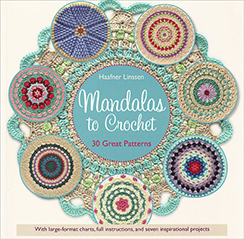
- Click here to find our picks for the best crochet books.
- Click here to find crochet stitch tutorials and instructions.
- Click here to learn more crochet techniques.
- Click HERE to Find Fabulous Yarn for Crochet and Knitting
- Click here to learn about crochet hooks.
- Click here to find my favorite crochet project bag.
Learn About Other Crafts: Knitting, Sewing, Quilting, Paper Crafts and More
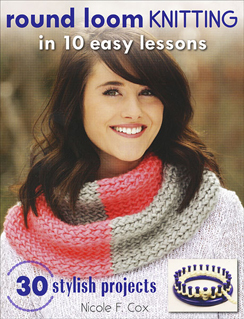
- Click here to get updated on the latest craft supplies.
- Click here to learn about knitting.
- Click here to find our beginner’s guide to knitting needles.
- Click here to find outstanding craft project ideas.
Posted By: Amy Solovay
Page last updated on 7-26-2023. Thanks for visiting!
